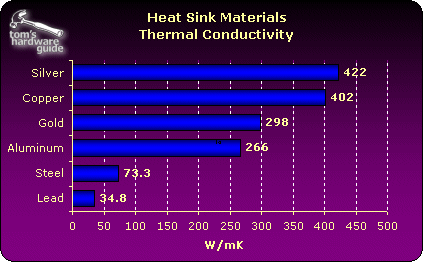A Comparison of 34 Coolers for the AMD Athlon XP
Theory: The Optimum Cooler
The demands placed on an optimum cooler by the user have not changed since the last test: it should be easy to fit and should, if possible, operate quietly. The cooling capacity provided should of course leave some room for a further processor upgrade.
Guidelines Of The Processor Manufacturer
The most important design parameters specified by AMD for an Athlon XP CPU cooler (Model 8) or the PXC housing are:
- Maximum total weight: 300 grams (for coolers that are clamped to the base);
- Maximum external measurements: 63 x 80 x 64 millimeters
- The internal temperature in the immediate vicinity of the cooler may not exceed 42 ° Celsius in any operating status;
- Maximum thermal output: 68.4 Watts;
- Nominal contact weight of the holding clamp: 9 kilograms.
Physical Peripheral Conditions
In order to be able to conduct heat away from the processor as quickly as possible, the following requirements need to be met: the material out of which the heat sink is made must be highly thermally conductive, and there has to be a sufficient temperature difference between the processor die and the surrounding air. In other words, the best cooler in the world is no good to you if the temperatures inside the housing are too high. For this reason, AMD recommends a maximum internal temperature inside the housing (measured at a distance of one inch above the processor ventilator) not exceeding 40° Celsius, and a temperature difference of at least 7° from the air surrounding the housing.
The cooling capacity or heat conductivity through a cooler can be described by the following equation (considerably simplified):
Iw = G*(TD -TA ) with G=λ* (A/l)
where
Iw : heat flux
G: heat conductance
λ: thermal conductivity of the cooling material
A: area through which heat flows (contact surface between the die and cooler)
l: distance traversed by the heat flux
TD : maximum permissible die temperature according to specifications
TA : temperature in the vicinity of the ventilator
Get Tom's Hardware's best news and in-depth reviews, straight to your inbox.
As can be deduced from the equation, given a specified temperature (TDmax =85°C and TAmax =40°C), the heat flux Iw increases the higher the thermal conductance (or the lower the thermal resistance) of the cooler, or to be more precise, the combination of cooler material, thermal interface material (TIM) and die material.
Thermal conductivity of various materials.
This explains the utilization of copper as the preferred cooling material: as the heat flux Iw corresponds to the processor's heat dissipation, cooling materials boasting higher thermal conductivity need to be used for CPUs with higher heat dissipation (=low thermal resistance).
Current page: Theory: The Optimum Cooler
Prev Page 34 Alternatives To The AMD Boxed Cooler Next Page Thermal Interface: Pad Or Paste